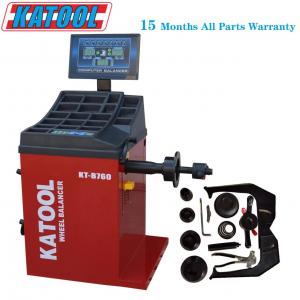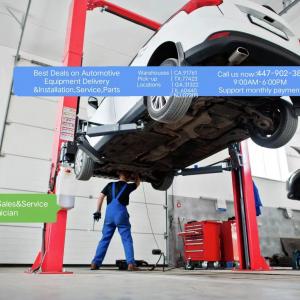Why Buy a Two-Post Auto Lift?
A two-post lift is a great option to raise or lower your vehicles as you need. There are many ways you can use a two-post lift, whether you're an individual looking for a vehicle lift for a personal garage, or you need lifts for a business. The benefits of having a two-post lift include:
•Saves space: If you only need to lift your car off the ground to perform some routine maintenance in your own garage, you won't need a huge two-post lift. Since the distance between the posts determines how much weight it can lift, if you just have a normal sedan our coup, a smaller two-post lift will work well, letting you save space and expand your garages' storage capabilities.
•Easy operation: Smaller auto shops and single users may not have the ability to use a lift that requires multiple people to operate. The simple operation of two-post lifts makes it an attractive option for many different users.
•Adjustable heights: Another benefit of two-post lifts is that you can use them in a variety of spaces with different ceiling heights. Some of the top two-post lifts can operate with ceiling heights as low as 9.5 feet.
Discover the different types of two-post auto lifts below.
Here are two basic types of two-post lifts — baseplate and overhead. In both types, the lift arms are attached to vehicular supports that move up and down along with the posts. To ensure maximum safety, the arms can be extended to keep each vehicle correctly balanced from front to back along the length of the two-post assembly. Essentially, the design and overall function of both post-lift types are roughly the same.
Despite their similarities, baseplate and overhead posts each come with different advantages. The main difference between the two is in the way they connect to their respective assemblies.
On the baseplate two-post lift, the assembly includes a plate that joins the two columns along the bottom. Essentially, the baseplate lift is akin to the outline of a large fish tank, with lines that run across the bottom and up each end at 90-degree angles. By contrast, the overhead two-post lift includes a piece that connects the two columns across the top, therefore boasting a shape more akin to one of the Stonehenge structures.
Whether you have a baseplate or overhead lift, along that plate is where the hydraulic power passes between the power and slave columns. In each type of auto lift, the internalized hydraulic system frees users from the hassle of entangled and possibly dangerous external cords.
Two-Post Lift With Baseplate
Installation of a two-post baseplate lift requires only a few simple steps. The plate that conceals the hydraulic mechanisms rests one inch above the floor. Externally, the only requirement is a flat, concrete floor on which to bolt the lift.
The main advantage of the baseplate lift is that it frees overhead space above the vehicle because it doesn't require an overhead component. Therefore, auto mechanics can use this lift with medium-height ceilings. The main drawback of the baseplate lift is that the plate can get in your way if you do transmission work. Consequently, the baseplate is not the best choice for auto-repair specialists who frequently perform transmission repairs.
Two-Post Lift Overhead Lift
When comparing a baseplate and overhead lift of the same carrying capacity side by side, the overhead tends to be the more stable of the two. This stability is due to the support of the overhead arch, which holds the columns together at the top instead of the bottom.
With a baseplate two-lift, the columns are inclined to cave inward due to the weight, and the pressure is only offset by the anchor bolts that keep the assembly mounted to the floor. By contrast, the overhead lift offers a natural stability akin to the Arc de Triomphe.
The overhead two-post lift also frees up ground space, which mechanics can instead use to park a vehicle or perform other tasks when the lift is not in use. However, you must ensure any overhead lift you choose has sufficient height for the vehicles you intend to service. If you work on larger vehicles, you'll need a higher overhead.
Maintenance work on the hydraulic component of an overhead two-post lift will generally require a ladder, whereas such components are easier to access on a baseplate lift.
Asymmetric vs. Symmetric
There are two additional variances to the range of two-post lifts on today's market — asymmetric and symmetric. The latter type of lift has two matching arms at the front and back. An asymmetrical lift uses differing arms at each end. The purpose of the asymmetrical lift is to allow access to the vehicle doors when necessary.
Symmetrical lifts are most suitable for work on longer vehicles, such as trucks and SUVs. To ensure door access, the posts should be aligned to the center of the vehicle. Since the majority of symmetrical lifts are overhead models, you must take height clearance into account if you operate in a smaller, low-ceiling work area.
Even though the lift arms are symmetrical, each includes extension components that allow you to adjust for the dimensional requirements of various vehicles. Long vehicles that are either unloaded at the rear or contain less back-weight generally require adjusted positioning on a symmetrical lift.
With asymmetrical lifts, the length of a vehicle needs to be placed roughly 30% beyond the front post and 70% beyond the rear, since 70% of vehicular weight centers on the engine sink of most cars, vans and trucks. As such, the shorter arms on an asymmetrical lift are at the front, while the longer arms are at the rear.




